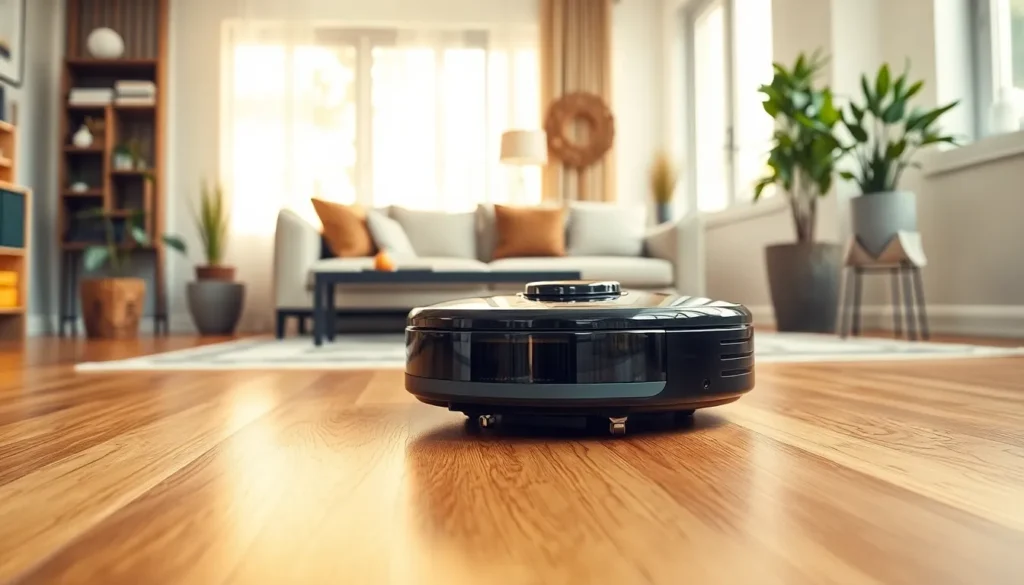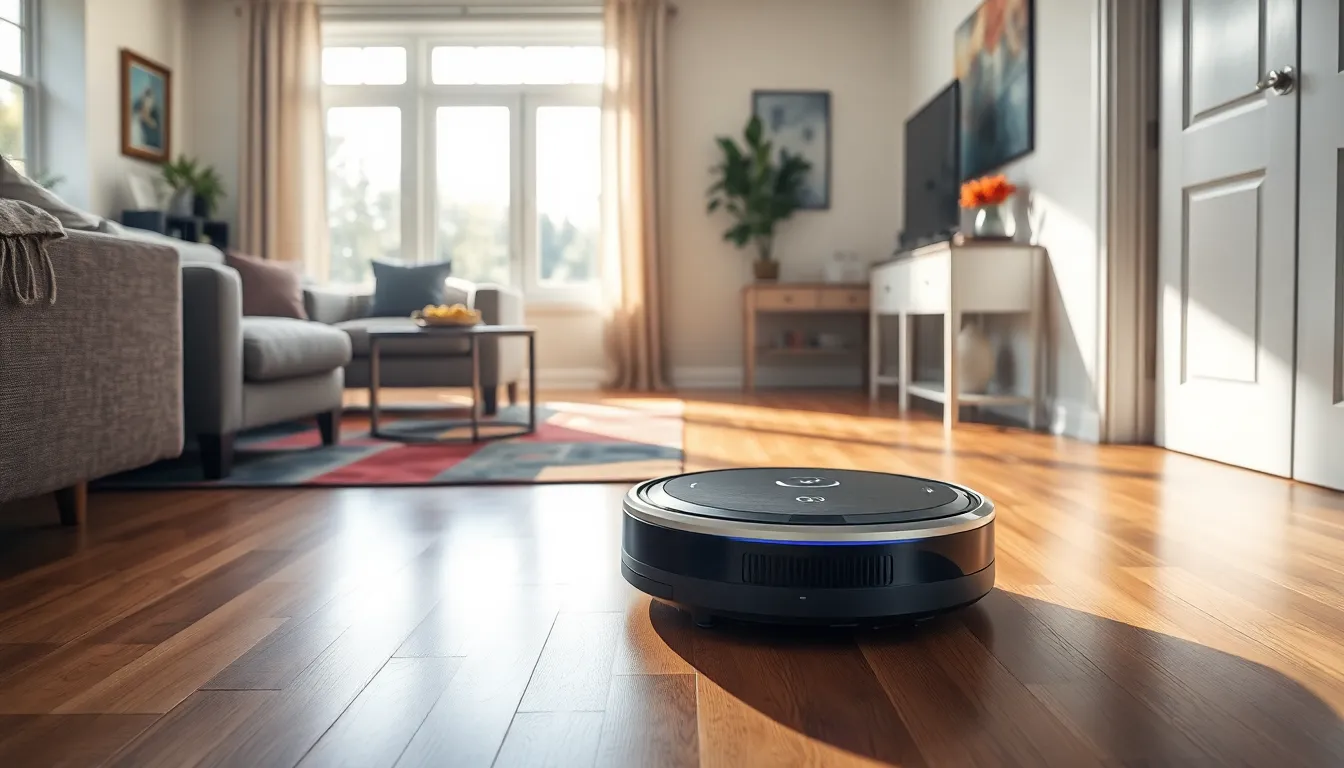Imagine a world where cleaning doesn’t involve dragging a heavy vacuum across the floor or wrestling with stubborn cords. Enter the robot vacuum, your new best friend in the battle against dust bunnies and pet hair. These little gadgets zip around your home, tirelessly sucking up dirt while you kick back with a cup of coffee or binge-watch your favorite series.
Table of Contents
ToggleOverview of Robot Vacuums
Robot vacuums simplify household cleaning by utilizing advanced technology for autonomous operation. These devices navigate through various floor types like carpet, tile, and hardwood without constant human intervention. Users benefit from programmed cleaning schedules, allowing robot vacuums to operate while they engage in other activities.
Intelligent sensors enable these vacuums to detect obstacles, avoiding damage and ensuring thorough cleaning. Many models also feature mapping technology, which allows for efficient navigation and coverage of an entire area. It adapts to different room layouts and avoids repeated cleaning in the same spots.
Battery life varies among models, with many robot vacuums operating for 60 to 120 minutes on a single charge. Some devices return to their charging stations automatically when the battery level is low, ensuring they remain ready for the next cleaning session.
Filters in robot vacuums capture dust, allergens, and pet hair effectively, contributing to a cleaner indoor environment. Maintenance is straightforward; users can easily empty dust bins and replace filters as necessary.
Most robot vacuums offer companion apps or voice control integration, enhancing user convenience. Through these features, users can monitor cleaning progress, adjust settings, and direct the device to specific areas. Overall, robot vacuums provide a practical cleaning alternative, combining technology and efficiency to meet modern cleaning demands.
Key Features to Consider
When selecting a robot vacuum, specific features greatly impact its effectiveness and user experience. Understanding these essential aspects allows for informed decisions.
Suction Power
Suction power significantly influences a robot vacuum’s cleaning efficiency. Many models range from 600 to 3,000 pascals. Higher suction power facilitates effective removal of dirt, dust, and pet hair. Users should consider models with adjustable suction settings for various floor types. Robot vacuums with strong suction can lift stubborn debris from carpets and hard floors effortlessly. Opt for devices equipped with multi-surface capability to enhance cleaning versatility.
Navigation Technology
Navigation technology ensures systematic cleaning coverage in homes. Advanced models utilize LIDAR and cameras for mapping and obstacle detection. These technologies enable efficient navigation around furniture, reducing missed spots. Some robot vacuums implement virtual walls or no-go zones, preventing them from entering certain areas. Users benefit from models that adapt their cleaning paths based on room layouts. Enhanced navigation capabilities enhance the automation experience significantly by improving overall cleaning performance.
Battery Life
Battery life impacts the robot vacuum’s operational efficiency. Most models operate between 60 and 120 minutes on a single charge. Extended battery life enables more thorough cleaning, particularly in larger spaces. Robot vacuums featuring self-charging capabilities return to their docks automatically when low on power. Selecting a device with an efficient battery management system can prolong cleaning sessions. Users should evaluate their cleaning needs to choose a model that fits their lifestyle.
Top Robot Vacuum Brands
Many consumers prioritize reliable brands when selecting a robot vacuum. Several top brands dominate the market, each offering unique features and capabilities.
iRobot Roomba
iRobot Roomba has established itself as a leader in the robot vacuum industry. Popular models feature advanced mapping technology that efficiently navigates spaces, ensuring thorough cleaning coverage. Users appreciate the customizable cleaning schedules available through the companion app. Roomba vacuums offer varied suction power, typically ranging from 600 to 2,500 pascals, which provides flexibility for different cleaning needs. Additionally, smart home integration adds convenience, allowing voice control through devices like Amazon Alexa or Google Assistant.
Neato Robotics
Neato Robotics stands out for its D-shaped design, enhancing corner cleaning capabilities. Many models utilize laser navigation for precise mapping and systematic cleaning paths. Customers value the option of Eco and Turbo modes, which adjust suction power based on needs. Battery life for Neato vacuums generally ranges from 60 to 120 minutes, ideal for larger spaces. The user-friendly app enables remote access and monitoring, providing control over cleaning schedules and settings.
Roborock
Roborock offers strong competition with its innovative features and robust performance. Users often commend the ultra-strong suction power, reaching up to 2,500 pascals, effective for various debris types. Advanced navigation technology, including LIDAR, ensures efficient mapping and obstacle avoidance. Battery performance can last up to 180 minutes, accommodating extensive cleaning sessions. Features like customizable cleaning zones and no-go lines improve user experience, allowing for targeted cleaning within specific areas of the home.
Benefits of Using a Robot Vacuum
Convenience defines the advantage of robot vacuums. These devices operate autonomously, freeing users from the repetitive task of traditional vacuuming. Users can program cleaning schedules, allowing the vacuum to run while they handle other tasks.
Thorough cleaning capabilities are another significant benefit. Intelligent sensors and mapping technology enable robot vacuums to navigate efficiently around furniture, ensuring comprehensive coverage. This prevents missed spots and maximizes the cleaning process.
Healthier indoor environments result from the filters in robot vacuums. They effectively capture allergens, dust, and pet hair, which is essential for maintaining air quality. Many models feature HEPA filters, specifically designed to trap microscopic particles.
Time-saving aspects contribute to overall user satisfaction. While technology allows for scheduled cleaning, the ability to start a vacuum remotely through apps enhances convenience. Many models also support voice control, making user interaction simple and efficient.
Maintenance of these vacuums is generally straightforward. Most users find emptying the dustbin and cleaning the brushes easy tasks. Frequent cleaning of filters helps maintain optimal performance, ensuring the vacuum operates at its best.
Battery longevity varies, with numerous models running from 60 to 120 minutes on a single charge. Some feature automatic charging, returning to their stations when their battery runs low. Longer battery life benefits larger homes, resulting in thorough cleanings without interruptions.
Ultimately, the advantages of robot vacuums combine convenience, efficiency, and health benefits. Investing in these devices aligns with modern living, simplifying household chores while enhancing overall cleanliness.
Potential Drawbacks
Robot vacuums present several potential drawbacks that users should consider before purchasing. Cleaning performance may vary based on surface types, with some models less effective on thick carpets. Noise levels can also be an issue, as many robot vacuums generate sounds comparable to traditional vacuums, which might disrupt daily activities.
Battery life poses limitations, particularly in larger spaces. Models with shorter operational times may require multiple charges to complete a full cleaning cycle. Navigation challenges can occur in homes with clutter, as devices may struggle to access tight spaces or recognize obstacles accurately.
Maintenance is another factor to keep in mind. Filters and brushes can clog with dirt and hair, necessitating regular cleaning. Users must also remember to empty the dustbin frequently to maintain optimal performance.
Cost remains a consideration, as robot vacuums generally range from $200 to $1,500, with high-end models featuring advanced functionalities. Budget constraints may limit options, especially for those seeking the latest technology.
Customer support varies across brands. Some manufacturers offer limited assistance or require lengthy warranty processes, which can cause frustration during troubleshooting.
Lastly, reliance on technology can become problematic. Occasionally, devices encounter connectivity issues, making app functionality less accessible. Modern households may require supplementary cleaning methods to achieve desired levels of cleanliness, meaning robot vacuums are not always a complete substitute for traditional cleaning.
Conclusion
Robot vacuums offer a remarkable blend of convenience and efficiency for modern households. Their ability to autonomously navigate and clean various surfaces frees up valuable time for users. With features like programmable schedules and smart navigation, these devices adapt to individual cleaning needs while promoting a healthier living environment.
While there are some drawbacks to consider, such as varying performance on different surfaces and potential noise levels, the advantages often outweigh the challenges. Investing in a robot vacuum can significantly simplify cleaning routines and enhance overall home cleanliness. As technology continues to evolve, these devices are likely to become even more efficient and user-friendly, making them an essential addition to any home.






